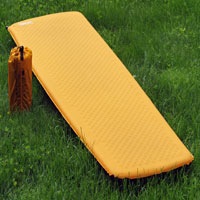Below are samples of some of the gear that I use while traversing Algonquin Park's interior. These are what I consider to be essential to my well being and comfort while in the back country. Remember, these are just examples of some of the gear I use. You can click on the corresponding topic in the sidebar on the right side of this page.

Rope has to be the simplest tool around. It is also the most versatile. Rope for me, is a constant companion in the back country of Algonquin Park. It makes my life easier and can be considered eco-friendly. If you are careful wrapping a rope around a tree to hang or string up materials, rope has less impact then say putting a nail into a tree to hang a rope. I use rope in a variety of situations, The following are just but a few of the examples;
- Hang my food pack
- Hang laundry to dry, air out sleeping bags
- "lining" my canoe
- balancing control of my canoe when portaging
- Hang my lantern and utensils
- Stake out my tent, hang my hammock
- Hang my water & food(when caching)
- A rescue line(with float), in the event of a waterborne rescue
- For tying up bad guys(never used, hope I never have to in Algonquin Park!)
- Tie my canoe to shore(Was very lucky to learn that lesson the easy way)
- Hanging paddles(If you know about beavers, then you know what I mean)
- Making an anchor(ok so I need a rock too, but without rope there's no hope!)
Return to Top of Page

The canoe pack I use is the 115 litre Eureka Canoe Pack. It is waterproof, accompanied with plenty of D-rings, handles & straps. This makes attaching extra amounts of gear to the pack exterior a snap. As well, the 2 extra handles in addition to the shoulder pads, make lifting and moving the pack easy. I can simply toss the pack into the canoe or onshore or even in the water if I wanted to test the waterproof-ness of the pack.
It is very easy to handle. There is also a removable adjustable hip belt. The belt is heavily padded as well as the portion of the pack, where one's lower back would be. One thing that is very noticeable is the weight of the empty pack. It is very light, a pleasant surprise.
The only issues I have had with this version of the pack I own is (a) the size and (b) softness of the pack. With the pack being able to hold 115 litres of gear, there is a tendency to pack more than I really need, "to fill the bag full". The second area of concern is that fact that the pack is not rigid at all. It is more like a sack and as such I must take care to pack breakable and rigid items into the centre of the pack.
Packing rigid items against the wall of the pack can add fatigue to the pack material, shortening its lifespan. Eventually a rip can occur and a patch will have to be applied. Beyond those two concerns, I think the pack was an excellent choice for me. The ruggedness factor is certainly there, lasting me several seasons so far. Hopefully it will last a few decades more. We shall see.
Return to Top of Page

I use an inflatable sleeping pad (A Therm-a-rest Pro-lite 4). Although it is advertised as self-inflating, it really isn't, at least in my case. No matter though, it only takes a minute or two to fill it with your own exhalations. Without a sleeping pad, I would suffer back pain and would probably catch a cold too. "Roughing it" doesn't mean I have to kill myself, rather it means to me to do without all the material things in life and focus only on that which is most important; comfort, function, & safety.
The sleeping pad insulates me from the cold damp ground, while providing a semi-firm flexible surface in which to lie my body upon comfortably. In much colder conditions(winter camping), in addition to the sleeping pad, I use those old blue foam pads, with a reflective layer of aluminium foil on the underside. The sleeping pad also has a no-slip surface on the underside, which is great as it’ll not slide around all over the tent. Unfortunately, if you are on any kind of slope, this does not prevent you (While in your sleeping bag) to slip and slide. Your pad might stay in place, but you will not. Hopefully future versions of this product will resolves this, although my pad is at least 5 years old, so who knows.
I find that instead of using my clothes pack as a pillow underneath my neck, I just slip my cloths pack (waterproof sack) under the pad. This provides a gentle incline, which for me helps me to breathe better while sleeping and doesn't slip, as in the past, I've had to go rummaging around in the middle of the night, re-adjusting my "pillow". The pad also dries off quickly should it become damp or wet. Under the strength of the summer sun, each side can dry in just a minute or two. I also use my sleeping pad during the daytime, to line my recreational hammock with. It keeps out the wind that robs my body of heat and it also provides a more comfortable and stable base on which to lie on while in the hammock.
To top it off, I can sleep quite well with a sleeping pad (versus the old foam pads) and they take up less room, packing quite small, about the size of a packed summer sleeping bag. A good night's sleep is important, else I can become exhausted. Yes, a sleeping pad to me is worth the investment; in both comfort and in keeping me warm and dry, thus reducing the risk of illness from cold, damp and/or exhaustion.
Return to Top of Page
